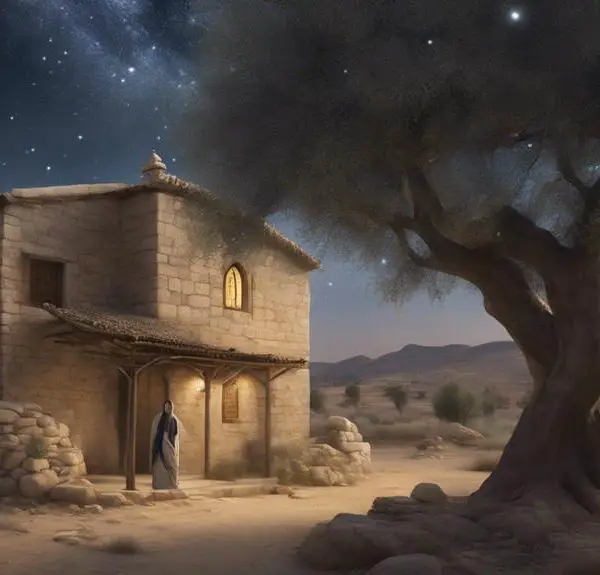Biblical stories of shelter reveal profound insights on divine protection and human vulnerability, inviting deeper exploration into faith's refuge.

Shelter in the Bible
Did you know that the concept of shelter appears over a hundred times in the Bible?
It's fascinating to see how this theme weaves through the narrative, from Noah's Ark offering protection from the Flood to the Cities of Refuge providing asylum.
As you explore these stories, you'll notice that shelter isn't just physical; it's deeply spiritual. The Psalmist, for instance, finds his refuge in God, highlighting an intimate aspect of faith.
Now, imagine uncovering the layers beneath these stories, where each account of shelter reveals a profound insight into divine protection and human vulnerability.
Let's explore what these narratives can teach us about seeking refuge in times of need.
Key Takeaways
- The Bible frequently uses shelter as a metaphor for divine care and protection.
- Wilderness experiences highlight the importance of trusting in divine provision for physical and spiritual needs.
- Cities of refuge in biblical times underscore the principles of justice, mercy, and the sanctity of life.
- Through teachings and parables, Jesus advocates for compassion, sanctuary, and inclusion for the marginalized and vulnerable.
Noah's Ark: Divine Shelter

Noah's Ark, as depicted in the biblical narrative, embodies the epitome of divine shelter, meticulously designed to preserve life amidst a world-engulfing deluge. This colossal structure wasn't just a sanctuary for Noah's family; it was a divine mandate to safeguard the continuity of all terrestrial life. You're drawn into a narrative that meticulously details the collection of animal pairs, emphasizing the Ark's role as a bastion against extinction. The instruction to gather species 'two by two' underlines a divine foresight in preserving biodiversity, showcasing an early recognition of ecological balance long before the term existed.
The construction materials for this monumental project—gopher wood and pitch—were specified with precise intention. Gopher wood, a term shrouded in mystery, suggests a material of remarkable durability or perhaps a divine specification beyond our understanding. The use of pitch, a waterproof sealing agent, underscores the ingenuity behind the Ark's design, ensuring it could withstand the relentless onslaught of the floodwaters. Through this analytical lens, you appreciate the Ark not just as a feat of divine engineering, but as a tangible manifestation of divine care and foresight, meticulously designed to ensure life's persistence on Earth.
Wilderness: Provision and Protection

ARTICLE TITLE: Biblical Shelter
PREVIOUS SUBTOPIC: 'Noah's Ark: Divine Shelter'
CURRENT SUBTOPIC: 'Wilderness: Provision and Protection'
In the tapestry of biblical narratives, the wilderness emerges as a multifaceted domain of divine provision and protection, offering both physical sustenance and spiritual fortification for those traversing its vast expanses. This desolate landscape, often depicted as a place of testing, also becomes a stage for extraordinary acts of divine care.
Event |
Description |
|---|---|
Manna Miracle |
Heaven-sent nourishment, appearing with the dawn, symbolizing God's daily provision. |
Quail Provision |
Evening arrival of quails, satisfying the hunger of the people, showcasing God's generosity. |
Water from Rock |
Miraculous quenching of thirst, illustrating provision in desolation. |
Cloud by Day |
Guiding and shading the people, a symbol of God's constant presence and protection. |
Fire by Night |
Illuminating the darkness, representing guidance and safety through perilous times. |
These instances highlight a profound truth: in the wilderness, where human resources dwindle, reliance on divine provision becomes paramount. The manna miracle and quail provision not only address physical hunger but also teach a deeper dependence on God, underscoring the wilderness as a crucible for faith.
Cities of Refuge: Asylum Laws

Just as the wilderness served as a divine provision for those in need, the biblical cities of refuge represent a meticulously structured asylum system, offering protection and justice for individuals seeking sanctuary. This ancient justice mechanism, deeply embedded within the Hebrew legal tradition, underscores the value of human life and the pursuit of fairness. The cities were designated spaces where individuals accused of manslaughter could flee to avoid revenge from the victim's family, awaiting a fair trial. This system highlights a sophisticated understanding of justice that balances the rights of the accused with the need for societal order.
Drawing parallels with modern asylum laws, the concept of cities of refuge illuminates the ongoing struggle to protect those at risk while ensuring the integrity of legal systems. Today's international asylum protocols, much like their ancient counterparts, aim to safeguard individuals from persecution, albeit in a vastly more complex global landscape. The principle of providing a safe haven for those in distress crosses cultural and temporal boundaries, underscoring a universal human value.
Analyzing the cities of refuge offers profound insights into the evolution of legal systems concerning protection and asylum. It showcases an early attempt to institutionalize mercy within the framework of ancient justice, a concept that continues to challenge and inspire modern parallels in legal discourse.
Jesus' Teachings on Refuge

In examining Jesus' teachings on refuge, it's evident that his messages emphasized compassion and sanctuary for the marginalized and oppressed. Delving into the Sermon on the Mount, you'll find Jesus laying the groundwork for a community built on empathy and understanding. Here, he blesses those who are poor, mourning, and persecuted, assuring them of their place in the kingdom of heaven. This isn't just about spiritual solace; it's a call for tangible support and shelter for those in need.
The parable of the Prodigal Son further illustrates Jesus' stance on refuge. It's a profound depiction of unconditional love and forgiveness, showcasing a father's willingness to provide shelter and acceptance, regardless of past transgressions. This story doesn't just speak to familial relationships but extends to how communities should welcome back those who've lost their way.
Jesus' teachings invite you to view refuge not as a mere physical shelter but as an act of profound spiritual and communal inclusion. His messages challenge you to create spaces of safety and belonging for everyone, especially the outcasts and sinners, embodying the very essence of divine compassion and hospitality.
The Psalmist's Shelter in God

Exploring the Psalms reveals a profound understanding of God as a steadfast shelter, offering refuge to those seeking solace amidst life's tumults. The Psalmists, through their poetic expressions, convey an intimate relationship with God, portraying Him as both a divine comfort and a spiritual fortress. This relationship is not a mere abstract concept but a lived experience, deeply rooted in the reality of their daily lives.
Psalm |
Aspect of Shelter |
Implication |
|---|---|---|
Psalm 23 |
Shepherd's care |
God guides and protects, providing safety and sustenance. |
Psalm 91 |
Refuge and fortress |
In God, one finds a secure haven against life's adversities. |
Psalm 46 |
Ever-present help |
God's unwavering support in times of trouble highlights His role as a reliable protector. |
Analyzing these Psalms, one discerns a multidimensional portrayal of God's sheltering presence. The Psalmists articulate their trust in God, who is consistently depicted as their bulwark against the vicissitudes of life. This divine shelter is not passive; it actively involves God's engagement with the world, offering protection, guidance, and comfort. Through these texts, one gains insight into the spiritual fortress that God provides, a sanctuary where faith is nurtured, and fear is dispelled.
Frequently Asked Questions
How Does the Concept of Shelter in the Bible Relate to Modern Homelessness and the Responsibility of Communities to Provide for the Vulnerable?
You're exploring how modern homelessness and community responsibility connect, focusing on community involvement and shelter policies.
Analyzing this, you'll find that it's crucial for communities to develop inclusive policies that not only provide shelter but also address the root causes of homelessness.
This approach reflects a broader understanding of care and support, emphasizing the importance of a collective effort in ensuring everyone has access to safe and stable housing.
In What Ways Do Biblical Narratives of Shelter Challenge or Reinforce Contemporary Architectural and Urban Planning Philosophies?
You're exploring how narratives of shelter influence today's architectural and urban planning philosophies.
These stories challenge you to rethink the use of sustainable materials and the concept of urban resilience.
By analyzing these narratives, you're pushed to design spaces that not only endure but also support community and inclusivity.
This approach reinforces the importance of resilience and sustainability in modern urban planning, echoing ancient wisdom in contemporary contexts.
Are There Examples in the Bible Where Individuals or Groups Are Denied Shelter, and What Lessons Can Be Drawn From These Stories?
You'll find stories where folks are denied shelter, deeply exploring hospitality norms and divine intervention. These tales offer lessons on compassion and the consequences of neglecting societal duties.
How Do Non-Christian Religions and Belief Systems Interpret the Biblical Stories of Shelter, and What Are the Similarities and Differences in Their Views?
When exploring how non-Christian religions view biblical shelter stories, you'll find varying interpretations and insights. Through interfaith dialogues, these differences and similarities come to light, enriching our understanding.
You'll see that cultural interpretations play a significant role in shaping these views. Some religions might find parallels in their texts, while others might offer contrasting lessons.
Analyzing these perspectives offers a broader, more nuanced comprehension of spiritual teachings on compassion and refuge.
What Psychological or Emotional Aspects of Seeking or Providing Shelter Are Explored in the Bible, and How Do These Themes Connect With Modern Understandings of Human Needs and Well-Being?
When exploring how people seek or provide shelter, you're delving into the realm of divine hospitality and emotional refuge.
These biblical themes deeply resonate with modern understandings of human needs and well-being, highlighting the psychological comfort found in offering or receiving shelter.
It's a testament to the enduring nature of these stories, showing how ancient wisdom on hospitality and refuge still informs today's perspectives on empathy, safety, and community support.
Conclusion
In analyzing the concept of shelter within the biblical narrative, it's clear that it transcends mere physical refuge. From Noah's Ark, symbolizing divine protection, to the wilderness and cities of refuge, shelter is intertwined with spiritual provision and mercy.
Jesus' teachings further emphasize refuge as a moral and spiritual imperative. The Psalmist encapsulates this melding of divine presence and protection, underscoring shelter's multifaceted nature as both a physical space and a spiritual sanctuary.
This theme reflects a profound theological and existential underpinning of shelter in biblical texts.



Sign up